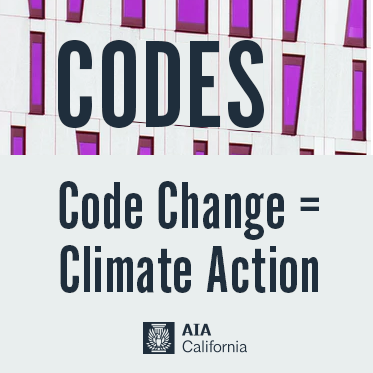To incorporate all three compliance paths that exist in the International Existing Building Code
 BY: Michael Malinowski, FAIA
BY: Michael Malinowski, FAIA
AIA California mirrors the architectural profession in making environmental stewardship and climate action central to its strategy and actions. We believe that the issue of climate change is urgent—a perspective shared by more than 1,700 governments around the world that have declared a climate emergency.[1]
Our 11,000 design professionals recognize that the urgency of climate action requires a new mindset in shaping our environment, with a high degree of sensitivity to how our choices can impact greenhouse gas emissions, both from operation of buildings, but also from embodied carbon. When looking at total greenhouse gas emissions for new buildings built over the next ten years — the critical period for action to address the global climate emergency — Architecture 2030 estimates that 80 percent will come from embodied emissions, so lowering embodied carbon emissions is now even more urgent than lowering operating emissions.[2] This means that in the coming years, leveraging our existing building infrastructure is going to be increasingly important. AIA CA believes this triggers a need for new focus on our California Existing Building Code.
The International Existing Building Code is unique among the ICC National Codes in having a focus on flexibility, presenting users with three compliance paths from which to choose.[3] Each of these paths: Prescriptive; Work Area, and Performance lead to safe, code-compliant buildings. Their differences allow design professionals to match the code path to the unique circumstances a particular existing building challenge can present. Like all ICC Codes, the IEBC has been developed over many years in a national open, transparent, consensus environment.[4] Thus, its provisions are well vetted and are already in use across the United States.
The Title 24 (T24) Part 2 “regular” building code is focused primarily on new construction, which involves predictable materials, systems, and process. Reusing existing buildings often requires increased flexibility and deep code analysis to ensure both feasibility and safe, functional and code-compliant outcomes. While we do have a robust Historic code (T24 Part 8) many older properties cannot access it. This leaves the California Existing Building Code (CEBC) as a primary tool.
Unfortunately, in its current state, the CBEC lacks key code path options that make the International Existing Building Code (IEBC) such a powerful and useful tool. The CEBC today only includes the Prescriptive methods, which have the most limited range of options. Other important code concepts, even those that had previously been in Chapter 34 of the IBC prior to the establishment of the IEBC as a separate code in 2005, are missing. We believe this lack of code flexibility in California makes reuse of our existing building stock less feasible due to higher costs and greater uncertainty – which in turn deprives us of the many benefits that come from updating, reusing and retrofitting existing buildings. Throughout our state, one can look up at empty unused downtown upper floors, and drive down obsolete commercial corridors, and appreciate the huge unrealized potential. The importance of having a robust and complete existing building code is addressed in detail in a white paper by the National Institute of Building Standards.[5] “The adoption of the IEBC in particular has broader community benefits by becoming a key element and driver of economic development; promoting affordable housing; allowing the reuse of existing building stock; and fostering the revitalization of older, often blighted and vacant neighborhoods. Building owners, developers and economic development authorities have flexibility to use methodologies that make the most sense for their project. The blighted or decaying communities become livable and vibrant again and the existing buildings become safer.”[6]
With more than 40 percent[7] of design professional work involving repair, alteration, renovation, and adaptive reuse of existing buildings, having additional flexibility will encourage and support additional adaptive reuse. While Architects and Code Officials find reusing existing buildings can present unique code challenges, these projects also can bring many important benefits to our communities:
- Existing buildings are packed full of embodied carbon, which stays in place when they are repurposed. This makes a large virtual contribution to decarbonization when contrasted with demolition and replacement.
- When Architects retrofit existing buildings – more than half of which are over 40 years old – we boost their energy efficiency, resiliency, function, and sustainability.
- Reusing existing buildings leverage the vast investments that have been made over many decades in existing infrastructure of our communities, such as streets, sidewalks, utility and service grids, and civic institutions like parks, schools, hospitals and more.
- Architects take pride in using the power of design to help connect our modern needs with our heritage and past. When we repurpose obsolete buildings in our urban centers for such new uses as attainable housing, mixed use lofts for live work, and other innovative new patterns of urban design, we breathe new life into our urban cores with walkable, sustainable, and resilient design solutions. Adaptive reuse supports progress in addressing such pressing issues as our state’s housing crisis, our decarbonization challenge, and our transportation bottlenecks.
AIA CA believes that adding all three compliance paths to the CEBC will benefit communities statewide, with the most likely immediate benefits to include a reduction in greenhouse gas emissions and the creation of more infill walkable housing. We are aware that this proposed change may be challenging to implement, but we believe the benefits in addressing California’s climate and housing crises make action important in this current code cycle. The AIA CA stands ready to assist with this process in any way we can. We also commit to fully informing our design professional members so they can make effective use of this new tool as soon as possible.
The AIA CA believes that the framework of the IEBC provides for protection of citizen health, safety and welfare while also supporting reuse, repurposing and retrofitting of our huge existing building stock to benefit our citizens. We also believe that building codes and Standards play a critically important role in environmental stewardship.
This is the basis for our petition to amend the CEBC
Outline of Proposed Code Changes
Adopt Chapter 6 Classification of work
Adopt Chapter 7 Alterations – Level 1
Adopt Chapter 8 Alterations – Level 2
Adopt Chapter 9 Alterations – Level 3
Adopt Chapter 10 Change of Occupancy
Adopt Chapter 11 Additions
Adopt Chapter 13 Performance Compliance Methods
How Can you Support this Effort?
The AIA CA welcomes letters of support for our code change petition. A CC to the AIA CA would be appreciated:
California Building Standards Commission
Mia Marvelli
Executive Director, California Building Standards Commission
Mia.Marvelli@dgs.ca.gov
CC to
Nicki Dennis Stephens, Hon. AIA
NDennis@aiacalifornia.org
[1] Over 1700 governments around the world have declared a climate emergency https://www.theclimatemobilization.org/climate-emergency/
[2] Embodied Carbon: what is it, why is it so important, and what can we do about it https://aiacalifornia.org/embodied-carbon-definitions-and-facts/
[3] IEBC overview https://www.structuremag.org/?p=10665#:~:text=The%20beauty%20of%20the%20IEBC,%2C%20and%20(3)%20Performance.
[4] The ICC Code Development Process How it Works; and By the Numbers https://www.iccsafe.org/products-and-services/i-codes/code-development/
[5] https://cdn.ymaws.com/www.nibs.org/resource/resmgr/ncgbcs/NCGBCS_IEBC_WhitePaper_2016.pdf
[6] The Role of Existing Building Codes in Safely, Cost-Effectively Transforming the Nation’s Building Stock A White Paper by the National Institute of Building Sciences National Council of Governments on Building Codes and Standards (NCGBCS) https://cdn.ymaws.com/www.nibs.org/resource/resmgr/ncgbcs/NCGBCS_IEBC_WhitePaper_2016.pdf
[7] American Institute of Architects, Renovate, retrofit, reuse: Uncovering the hidden value in America’s existing building stock (Washington, D.C.: AIA 2019)




 The AIA CA supports decarbonization of the built environment, and the reach codes that have allowed such rapid movement forward in supporting climate action. We also believe that these objectives will be more efficiently served when there are uniform, nationally vetted standards put into place to achieve them. One such national standard is the ZeroCode, developed by the non-profit Architecture 2030 organization, a world leader in climate action innovation. This code has been officially vetted and approved to be an appendix in the International Energy Conservation Code for 2021.
The AIA CA supports decarbonization of the built environment, and the reach codes that have allowed such rapid movement forward in supporting climate action. We also believe that these objectives will be more efficiently served when there are uniform, nationally vetted standards put into place to achieve them. One such national standard is the ZeroCode, developed by the non-profit Architecture 2030 organization, a world leader in climate action innovation. This code has been officially vetted and approved to be an appendix in the International Energy Conservation Code for 2021. 





